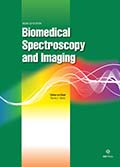Authors: Klare, Johann P.
Article Type:
Research Article
Abstract:
EPR spectroscopy is the most straightforward-to-use technique for studying free radicals and other paramagnetic species and has therefore established itself in biomedical research and for clinical applications. EPR found its applications in oximetry, where this technique allows repeated measurements of oxygen in tissues – also in vivo and in combination with imaging techniques. The direct detection of paramagnetic species like transition metal ions by EPR allows elucidation of their specific roles in disease, for example how copper ions might be involved in the formation of amyloid- or amyloid-like fibrils in neurodegenerative diseases. For investigations on the structures of this protein
…aggregates, but also of other proteins or protein complexes with medical relevance the technique of site-directed spin labeling (SDSL) – the site-specific introduction of paramagnetic reporter groups into proteins or nucleic acids – is nowadays frequently used, especially in cases where other structural techniques are not applicable. Moreover, by direct detection of free radicals – also in combination with spin trapping methods, or application of SDSL, EPR spectroscopy can be also used for diagnostic purposes, e.g. in cancer diagnostics. This review gives an up-to-date overview about how EPR spectroscopy is currently used in biomedical research and clinical applications, with special emphasis on biomedical applications of SDSL EPR.
Show more
Keywords: Electron paramagnetic resonance spectroscopy, biomedicine, site-directed spin labeling, spin trapping, oximetry, diagnosis, prognosis, infection, structural biology, reactive oxygen species, nitric oxide, free radicals, EPR imaging, in vivo EPR
DOI: 10.3233/BSI-2012-0010
Citation: Biomedical Spectroscopy and Imaging,
vol. 1, no. 2, pp. 101-124, 2012
Price: EUR 27.50





